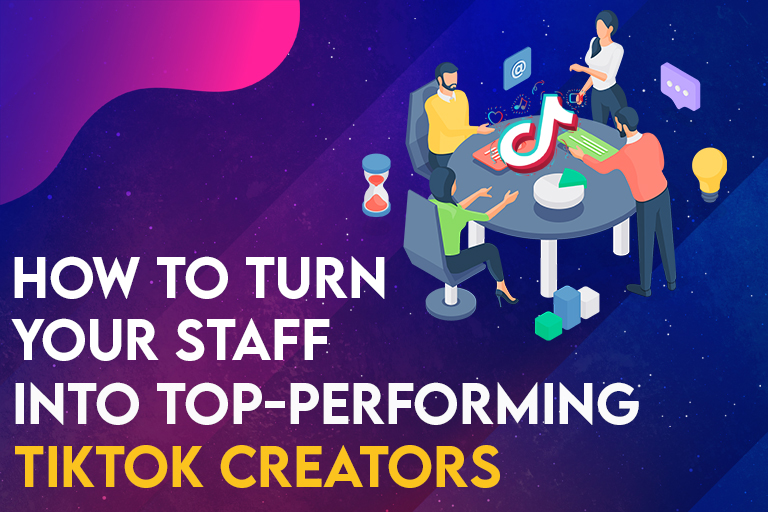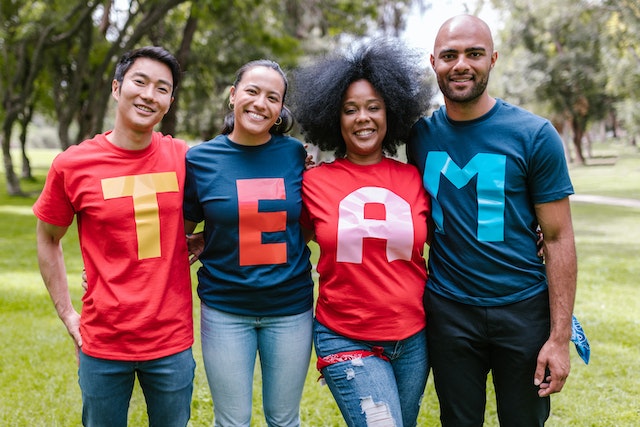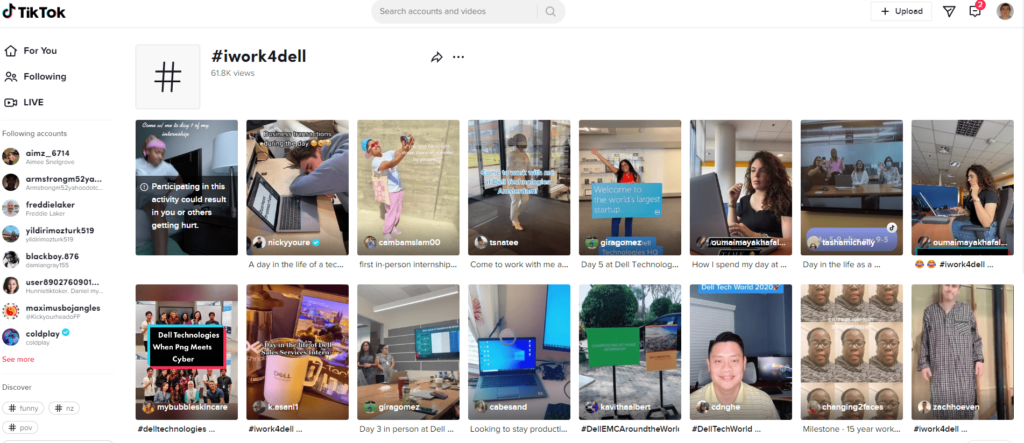
While some businesses have strict rules discouraging their staff from referencing their workplace on TikTok and other social media, many actively encourage it. Brands are beginning to recognise the benefits of allowing motivated staff to share TikTok videos. We recently wrote about 7 secret ways in which brands can thrive on TikTok. In this article we have another hidden gem that many brands just don’t consider. You might have concerns about your employees sharing horror stories online. But this should not be an issue if you have a predominantly contented workforce. Indeed, many brands have significantly benefited from employee advocacy, helping turn their staff into creators.
Employment Advocacy on TikTok
We call employees talking positively about or promoting their companies on a public platform like TikTok employee advocacy. If a company’s employees say good things about the company, then people find it easier to believe than when the company promotes itself.
Should You Allow Employees to Use TikTok at Work?

Letting employees use TikTok and other social media at work has always been a conundrum for many firms. As a result, many have strict rules forbidding the practice. Indeed, in 2019, Gartner surveyed 239 large corporations and found that more than 50% were using non-traditional monitoring techniques like analysing the text of emails and social-media messages. A year later, Accenture found that 62% of the C-level executives surveyed said their organisations were using new technologies to collect data on their people and work to gain more actionable insights.
Many companies aren’t happy about employees posting during their work hours. And some even dislike employees referencing their place of employment at all. They are worried that employees will harm their brand reputation and potentially open them up for legal issues. Some managers even worry that their employees will make overly-critical posts about their workplace.
However, workers can just as easily make positive posts about the workplace, which can significantly benefit a company. Therefore, many organisations are coming up with a compromise position. For example, they may allow employees to make work-related posts as long as they agree to keep things positive and keep away from agreed contentious issues.
Some brands even allow some posting during work time as long as it doesn’t detract from employees’ performance or become a safety issue.
Why Turn Your Staff into TikTok Creators?
Employee advocacy is an effective marketing technique used by many brands. You can convert your employees into brand advocates and tap into their social networks. For example, if you employ a relatively young workforce, you’re likely to have quite a few employees on TikTok, many of whom create content on that platform. And, if you have a substantial number of brand advocates with large follower bases, you could reach even more people than you could have on your own.
Another advantage of turning your staff into TikTok creators is that content posted by regular people gets much higher engagement than that posted by brands. People consider this content more authentic and relatable than any promotional content your brand could create.
While nobody appears to have collected data about TikTok employee advocacy yet, we do have some about employee advocacy, in general, that show the effectiveness of working with your employees and their social accounts. For example, according to Oktopost’s B2B CMO Survey in 2021, nearly half of CMOs stated that employee advocacy was their best-performing social initiative. In addition, Oktopost dug deeper and found that using an employee advocacy program increased total social engagement for a brand by 25% to 40% at minimum.
Turning your staff into creators on TikTok can also help your team bonding, particularly if your employees naturally use TikTok anyway. It can help your staff feel more valued and a better fit for the company. This is because they build their personal brands simultaneously as they build bonds with customers and other interested stakeholders.
Allied with this is that having your staff act as TikTok creators means you benefit from increased user-generated content (UGC). And UGC serves as excellent social proof. Whether this UGC comes from your employees or your customers, it increases your credibility.
Mae Karwowski, CEO of Obviously, observes, “Employees can be your best advocates because they know and love the brand; they know all the ‘hacks’ and insider info.” However, she adds, “The first step is to give guidelines to employees… monitor and reward positive behaviour.”
Goals of TikTok Employment Advocacy

Whether you turn your staff into TikTok creators or engage in more traditional marketing techniques, you should always begin your campaign by determining goals. There has to be some reason why you are marketing, something you want to achieve.
Having clarity about the goals of your TikTok employment advocacy campaign will help you measure the program’s performance against those goals. How can you possibly know whether you are being effective if you don’t have some yardstick against which you can measure your success?
You don’t have to express your goals in monetary terms, although you could very well set a goal relating to improving sales due to your employee’s TikTok posts. Typical non-monetary goals you could set include:
- Increasing your website count
- Growing your follower count (to your brand’s TikTok or other social accounts)
- Generating leads
- Enhancing your brand image with your target audience
You will want to express your goals in SMART terms (Specific, Measurable, Achievable, Relevant, Time-Targeted).
So, for example, as you turn your staff into creators, you might challenge them to use their TikTok accounts to direct their followers to visit your website over the next month, resulting in a 25% increase in site visitors (as measured by Google Analytics).
Encouraging Your Staff to Participate
For a TikTok employee advocacy program to succeed, you need willing, active team members who feel positive about their work and, ideally, already have a TikTok presence. Therefore, you must ensure a positive workplace and culture before considering such a program. Some companies have had disgruntled employees unofficially create TikTok videos where they have criticised and mocked their employer.
However, as much as you might worry about employees sharing inappropriate TikTok videos, you can’t expect to have too much control over their creative process. They are more likely to understand what their followers like than you, particularly if you are not part of the “TikTok generation”. Therefore, you will need to build up a level of trust with potential campaign participants.
This doesn’t mean that you should let your employees loose in a TikTok free-for-all. You can set reasonable expectations for your staff when making videos for TikTok or any employee advocacy across their social media. Starbucks, for instance, includes the following common-sense sections in their employee advocacy guidelines:
- Do not let social media posting get in the way of your job.
- Don’t act like a spokesperson for the company and direct all media queries to the right person.
- Do not post any sensitive or confidential information that should not be publicly disclosed.
- Use the #tobeapartner hashtag on all company-related social media posts
That last point exemplifies how brands can tie their employees’ work-related TikTok and other social content together. Everybody involved uses a common hashtag throughout all their posts. Hashtags can be incredibly important on TikTok, so much so that one of TikTok’s premier advertising types is the Branded Hashtag Challenge.
Essential Steps in Creating Your TikTok Employee Advocacy Programme
The most critical phases of your TikTok employee advocacy programme are announcing the program to your staff, finding suitable leaders, and implementing your campaign. Remember, your employees need to be the centre of your programme – not your business – and gaining their buy-in is essential.
However, you will also have to get executive buy-in. You will struggle to turn your staff into top-performing TikTok creators sharing on behalf of your company if management doesn’t support the programme. Ideally, your executives should lead by example, engaging on social media (not necessarily TikTok if that’s not their thing) and actively promoting the initiative.
You will also want to set up a system to help employees create employee-generated content (EGC). This will help employees bridge the gap between branded and unbranded content while respecting your company’s policies and guidelines. You can also ensure that all your employees have equal access to suitable assets for their promotional content.
Onboarding Staff into Your TikTok Employment Advocacy Programme

You can do many things to onboard employees into your scheme. However, much of this success will rely on you selecting suitable leaders for the project who understand your company ethos well and are experienced, TikTok creators.
Your staff will probably have a wide range of TikTok experience and technical skills. Some will need considerable handholding at the beginning of their involvement with the scheme. Others will already be making and sharing content on the platform regularly, needing little assistance apart from ensuring that they don’t go outside company rules with their posts.
Some staff might need to create new professional TikTok accounts, possibly thanks to their history on the platform. Others may be experienced social users elsewhere, perhaps on Instagram or Facebook, but want to set up a TikTok account so they can participate in the programme. If you assist in setting up professional TikTok accounts for your team, you have a better chance of ensuring employees follow company guidelines.
It is well worth spending time training your advocates. Even your most experienced TikTokers aren’t necessarily experts at advocating their workplace online. Also, employee training ensures that everybody starts from the same position, and you can set a minimum knowledge level for your employees. Some firms use an employee advocacy tool, such as Ambassify, Oktopost, or Sociabble, to help manage the scheme. Part of your onboarding would involve training staff in its use.
Personal Qualities That Will Help Turn Your Staff into Creators
An essential requirement for successfully integrating your staff into a TikTok employee advocacy scheme is a willingness to be genuine and authentic.
If your employees come across as real, they will inspire trust in their friends and family and even find their videos as For You suggestions.
Sure, it helps if your employees can make a good video, but technical proficiency is not particularly valued on TikTok. If videos look too polished, they lose that touch of authenticity, and people rapidly can lose interest and trust. Ideally, any videos your staff make on your behalf should be similar in style to the videos they usually share.
You will want to draw on your employees’ expertise, insights, personalities, strengths, and passions.
Examples of TikTok Employment Advocacy in Practice. Official and Unofficial
1. TikTok
Perhaps the best place to start with a brand turning its staff into creators on TikTok is TikTok itself. The social network launched an Employee Creator Program to encourage awesome employee creators to share their stories on its LifeatTikTok TikTok page.
One employee TikTok has highlighted is Sophia Iwaniuk, a London-born Ukrainian, now a Quality Analyst at TikTok. As such, she spends her days looking at TikTok videos. She also has a brother who’s a full-time TikTok creator. However, none of this has discouraged Sophia from creating her content. As she says, “I hope to share not only the highlights of my life as a TikTok employee but also the regular everyday moments that make TikTok such an amazing platform.”
2. GameStop
American video game retailer, GameStop, has actively encouraged its employees to participate on TikTok. They invited employees to submit dance videos in the hopes of winning prizes that included extra work hours during the Black Friday shopping period.
“Be creative, rope in your team, and have fun with it! Don’t worry; you can’t look as bad as the event team does!” is a prompt for one of GameStop’s employee contests, the Incisiv TikTok Dance Challenge. Employees could create any dance routine video set to UB40’s “Red Red Wine”. The winning store received an Echo 8, Echo Auto, a $100 Visa gift card, and “10 additional labour hours” to use during Black Friday week.
3. Starbucks
Starbucks baristas were initially confused when Gen Z customers began to order the “TikTok” drink. This was an off-menu item, never promoted nor officially recognised by the brand. Those baristas on TikTok understood what was going on, however: start with a Strawberry Açaí Refresher, three scoops of strawberries, three scoops of blackberries, blended with ice or lemonade. #TikTokDrink started as a Grande viral trend but now has 580.9 million views.
Passionate employees stepped in to promote their favourite drinks, often providing barista commentary on their accounts. These were unsponsored and uninfluenced by their managers but highly popular and successful.
Now you can find many TikTok videos by Starbucks employees at @starbucksbarista, currently sitting on a phenomenal 1.3 billion views.
4. Dunkin’
Dunkin’ operates a more formal employee ambassador scheme with their Dunkin’ TikTok Crew Ambassador program. Indeed, they have even held contests to find the best crew members to add to the programme.
For example, the company held the #DunkinCrewContest, where interested employees could enter for the chance to become a TikTok crew ambassador and get their signature drink creation on the menu at their local Dunkin’.
@dunkin 📢CALLING ALL DUNKIN’ CREW📢 Want to be a Dunkin’ TikTok Crew Ambassador? Show us what you’ve got with #DunkinCrewContest 🙌
Crew Ambassadors post clips from their jobs, often featuring new Dunkin’ products. Digiday reported that Dunkin’ said in an email that “each crew member who participates in the crew ambassador program is compensated for their work and content,” but didn’t comment on the form compensation takes.
Unfortunately, the contest was only available to US employees, although that didn’t stop people from the UK from commenting on how they wished they had the opportunity.
5. Dell
Dell has seen the advantages of empowering its workforce on social media. However, they recognised that employees must want to be part of the program, sharing interesting and entertaining content rather than official corporate communications. So, they aimed to build an experience where team members could discover, curate, and share interesting content across their social accounts.
Dell launched a formal social media program for its workforce. Employees undertook four hours of social media training to participate. The company then launched a tool to operate their employee advocacy program, supporting Dell’s overarching plan.

What Types of Content Should You Encourage Your Staff to Share on TikTok?
If you haven’t kept up-to-date with the meteoric rise of TikTok, you might think that people simply share lip-syncing videos to music on the platform. And indeed, that is how TikTok started. However, things have advanced considerably since then, and you’ll now find many more types of content on TikTok. You will also notice that TikTok has widened its appeal. It even has a dedicated audience of older people if that is your market demographic.
Some of the more common types of posts you could encourage your employees to share include:
- Daily routine videos give viewers insight into the work happening at your business
- Sharing content that reflects your brand’s values
- Spotlighting your employees
- Sharing information that will inform viewers on things related to your industry or niche
- Product campaigns and promotions for new launches
- Sharing a story about your business
- Answering audience questions
- Product demonstrations
- Highlighting your production process
- Using trending sounds and hashtags – as long as your employees can make them relevant to your business
However, you might need to consider the music used in the videos your employees share. Any posts created and shared by individuals and don’t look like advertising can probably use any of the music cleared for individual use on TikTok (most popular songs). However, if your employees share posts that clearly promote your business, they could become tied up in music copyright issues. In that case, it is probably worth ensuring that your employees and content creators select music from TikTok’s royalty-free music library for ad content as the background to their TikTok videos.

House of Marketers (HOM) is a leading TikTok Marketing Agency. Our global agency was built by early TikTok Employees & TikTok Partners, which gives us the insider knowledge to help leading brands, like Redbull, Playtika, Badoo, and HelloFresh win on TikTok. Want us to convert more of Gen Z and Millennials with TikTok? Get in touch with our friendly team, here.